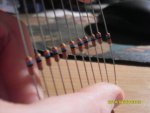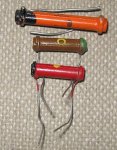Hi,
I was going through my resistors to sort them and came across these:

I don't remember how to read these old resistors, which side is which, or even the difference between these and the new resistors.
I hope that anyone remembers these and can help me tell the values.
I hope that these are read the same as resistors today.
Please help.
Thanks,
Technokid
I was going through my resistors to sort them and came across these:

I don't remember how to read these old resistors, which side is which, or even the difference between these and the new resistors.
I hope that anyone remembers these and can help me tell the values.
I hope that these are read the same as resistors today.
Please help.
Thanks,
Technokid



